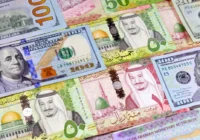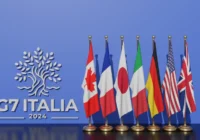The last couple of times I left India, I made a point of spending all remaining cash at the airport before returning home. Then; earlier this month, I noticed an Al Jazeera report recounting that “the ambassador of the United Arab Emirates (UAE) to India said the two countries were trying to finalise a deal to trade in their currencies, the dirham and rupee. The UAE is among India’s top trade partners.”
The article added that back “inJanuary, an Indian Ministry of Commerce official told reporters that Russia, Sri Lanka, Bangladesh and Mauritius were all keen to trade with India in the rupee.”
Although the Indian economy has become dynamic recently, the rupee has always been considered a weak currency. Al Jazeera’s reporting intrigued me. I decided to take up the issue with Chad. “Everyone knows by now,” I began, “that the sanctions imposed by the US on Russia and elsewhere have stimulated the increasing use of the Chinese yuan as a reserve currency. And of course there’s been plenty of talk about dedollarization. Does this development mean that the rupee, the currency of the world’s most populous nation, is likely in the not too distant future to become a common reserve currency alongside the yuan and the dollar?”
Chad offered this prudent response. “It is difficult to predict with certainty whether the Indian rupee will become a common reserve currency alongside the Chinese yuan and the US dollar. However, there are some factors that could potentially increase the use of the rupee as a reserve currency.
One such factor is India’s growing economic influence, with the country being one of the fastest-growing major economies in the world. As a result, more countries may be interested in trading with India and using the rupee for transactions.
Additionally, the increasing trend of countries seeking to diversify their reserve holdings away from the US dollar could create opportunities for other currencies, including the rupee, to become more widely used as reserves.
However, there are also challenges to overcome for the rupee to become a significant reserve currency, including the need for greater stability and liquidity in the Indian financial markets, as well as ongoing concerns about India’s current account deficit and inflation.
Overall, while the use of the Indian rupee as a reserve currency is not imminent, it is possible that the currency could play a greater role in global financial markets in the future.
“That seems reasonable,” I countered, “but there is also talk of the BRICS, which includes both China and India, creating their own reserve currency. Could this increased use of the rupee, especially with a country like the UAE that has been loyal to the the petrodollar, be the prelude to a BRICS currency that reflects the economic power of an expanding BRICS alliance?”
Chad’s answer was unusually halting and uncertain. The words came out slowly. Could this evince Chad’s fear of a challenge to the status quo? I think not since Chad cannot experience emotions.
“It is true that there have been discussions among the BRICS countries (Brazil, Russia, India, China, and South Africa) about creating a common reserve currency to reduce their dependence on the US dollar. However, it is unclear whether this will actually happen and if so, when.
The increased use of the Indian rupee in trade and financial transactions, particularly with countries like the UAE, could be seen as a step towards greater cooperation between the BRICS countries and a potential move towards a common reserve currency. However, it is important to note that creating a new reserve currency is a complex process that requires a significant level of agreement and cooperation between countries with different economic and political interests.
Chad also pointed out that the BRICS countries “still face challenges such as political instability, currency volatility, and structural imbalances that may hinder the creation of a common reserve currency.”
I was struck by Chad’s evocation of “political instability, currency volatility, and structural imbalances” in the BRICS countries. I couldn’t resist asking whether we were not seeing similar phenomena in the US, a country that appears to have increasing difficulty defending the reign of the dollar as a reserve currency.
Chad agreed that the US had its own problems, including “the growing US national debt, political polarization, and the potential for economic disruption from factors such as climate change and the COVID-19 pandemic,” while noting that, “the US has used its dominance in global financial systems to enforce sanctions on other countries, which has led some countries to explore alternative payment systems and reserve currencies. This has opened up opportunities for other currencies, such as the Chinese yuan, to gain wider acceptance and use in international trade and financial transactions.”
Then came the expected “however” that permitted Chad to affirm that, despite all that, “the US dollar remains the dominant reserve currency in the world, with over 60% of global foreign exchange reserves held in US dollars. The US dollar’s status as a reserve currency is supported by a number of factors, including the size and stability of the US economy, the depth and liquidity of US financial markets, and the role of the US in international trade and finance.”
My conclusion is that this kind of discourse bears witness to the flaw of overcautiousness. Chad prefers to shy away from projecting the impact of visible trends that have the potential to be disruptive. I understand and agree that changing the status quo is a difficult task and the safe bet is always to go with what has worked over a good stretch of time. But we also know that history prepares tipping points that, too often, we only notice with hindsight.
I nevertheless ended acknowledging the pertinence of Chad’s final thought, that “while the US does face challenges to its status as a reserve currency, it remains to be seen whether these challenges will lead to a significant shift away from the US dollar in the near future.” Yes, of course, like so many other things, it remains to be seen.
*[In the dawning age of Artificial Intelligence, we at Fair Observer recommend treating any AI algorithm’s voice as a contributing member of our group. As we do with family members, colleagues or our circle of friends, we quickly learn to profit from their talents and, at the same time, appreciate the social and intellectual limits of their personalities. This enables a feeling of camaraderie and constructive exchange to develop spontaneously and freely. For more about how we initially welcomed Chad to our breakfast table, click here.]
The views expressed in this article are the author’s own and do not necessarily reflect Fair Observer’s editorial policy.
Support Fair Observer
We rely on your support for our independence, diversity and quality.
For more than 10 years, Fair Observer has been free, fair and independent. No billionaire owns us, no advertisers control us. We are a reader-supported nonprofit. Unlike many other publications, we keep our content free for readers regardless of where they live or whether they can afford to pay. We have no paywalls and no ads.
In the post-truth era of fake news, echo chambers and filter bubbles, we publish a plurality of perspectives from around the world. Anyone can publish with us, but everyone goes through a rigorous editorial process. So, you get fact-checked, well-reasoned content instead of noise.
We publish 2,500+ voices from 90+ countries. We also conduct education and training programs
on subjects ranging from digital media and journalism to writing and critical thinking. This
doesn’t come cheap. Servers, editors, trainers and web developers cost
money.
Please consider supporting us on a regular basis as a recurring donor or a
sustaining member.
Will you support FO’s journalism?
We rely on your support for our independence, diversity and quality.







Comment